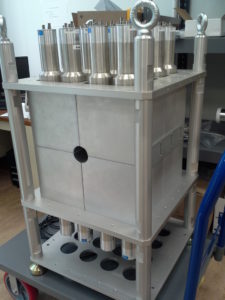 The p-process occurs in oxygen-neon burning layers of the Supernova, where, during earlier evolution stages, the neutron-rich nuclei were produced by the s-process. During the SN explosion, gamma-rays traverse through the SN layers destroying the s-nuclei during a series of (γ,n) reactions. The abundances shift towards proton rich nuclei, which undergo further photodisintegration via (γ,p) and (γ,α) reactions. Once the shockwave passes, the produced unstable nuclei β-decay towards the valley of stability producing the p-nuclei. A proper description of this process requires network calculations that involve several thousands of nuclear reactions, for most of which the cross sections have not been experimentally verified.
The p-process occurs in oxygen-neon burning layers of the Supernova, where, during earlier evolution stages, the neutron-rich nuclei were produced by the s-process. During the SN explosion, gamma-rays traverse through the SN layers destroying the s-nuclei during a series of (γ,n) reactions. The abundances shift towards proton rich nuclei, which undergo further photodisintegration via (γ,p) and (γ,α) reactions. Once the shockwave passes, the produced unstable nuclei β-decay towards the valley of stability producing the p-nuclei. A proper description of this process requires network calculations that involve several thousands of nuclear reactions, for most of which the cross sections have not been experimentally verified.
However, the photodisintegration reactions ((γ,p) and (γ,α)) can be studied through the principle of detailed balance via their inverse, i.e. (p,γ) and (α,γ) on proton rich nuclei. My goal is to contribute to the better understanding of the production of the p-nuclei by identifying nuclear reactions that are important for the p-process (sensitivity studies) and measuring cross sections for such reactions.
For this purpose I designed a NaI(Tl) summing detector, HECTOR (High Efficiency TOtal absorbtion spectrometeR) that utilizes the gamma-summing technique for measurements of the proton and alpha capture reactions. High efficiency of the detector makes it an ideal tool for measurements of the cross sections for the cases when the level scheme is not know or is very complicated making it difficult to extract the cross sections from high resolution spectra.

